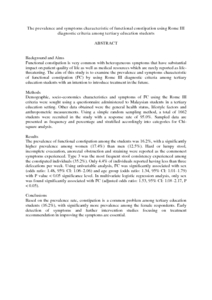Citation
Lim, Ying Jye and Jamaluddin, Rosita and Chieng, Jin Yu and Hazizi, Abu Saad
(2016)
The prevalence and symptoms characteristic of functional constipation using Rome III diagnostic criteria among tertiary education students.
PLOS ONE, 11 (12).
art. no. e0167243.
pp. 1-14.
ISSN 1932-6203
Abstract
Background and Aims
Functional constipation is very common with heterogeneous symptoms that have substantial impact on patient quality of life as well as medical resources which are rarely reported as life-threatening. The aim of this study is to examine the prevalence and symptoms characteristic of functional constipation (FC) by using Rome III diagnostic criteria among tertiary education students with an intention to introduce treatment in the future.
Methods
Demographic, socio-economics characteristics and symptoms of FC using the Rome III criteria were sought using a questionnaire administered to Malaysian students in a tertiary education setting. Other data obtained were the general health status, lifestyle factors and anthropometric measurements. Using a simple random sampling method, a total of 1662 students were recruited in the study with a response rate of 95.0%. Sampled data are presented as frequency and percentage and stratified accordingly into categories for Chi-square analysis.
Results
The prevalence of functional constipation among the students was 16.2%, with a significantly higher prevalence among women (17.4%) than men (12.5%). Hard or lumpy stool, incomplete evacuation, anorectal obstruction and straining were reported as the commonest symptoms experienced. Type 3 was the most frequent stool consistency experienced among the constipated individuals (35.2%). Only 4.4% of individuals reported having less than three defecations per week. Using univariable analysis, FC was significantly associated with sex (odds ratio: 1.48, 95% CI: 1.06–2.06) and age group (odds ratio: 1.34, 95% CI: 1.01–1.79) with P value < 0.05 significance level. In multivariate logistic regression analysis, only sex was found significantly associated with FC (adjusted odds ratio: 1.53, 95% CI: 1.08–2.17, P < 0.05).
Conclusions
Based on the prevalence rate, constipation is a common problem among tertiary education students (16.2%), with significantly more prevalence among the female respondents. Early detection of symptoms and further intervention studies focusing on treatment recommendation in improving the symptoms are essential.
Download File
![[img]](http://psasir.upm.edu.my/53067/1.hassmallThumbnailVersion/The%20prevalence%20and%20symptoms%20characteristic%20of%20functional%20constipation%20using%20Rome%20III%20diagnostic%20criteria%20among%20tertiary%20education%20students.pdf)  Preview |
|
PDF (Abstract)
The prevalence and symptoms characteristic of functional constipation using Rome III diagnostic criteria among tertiary education students.pdf
Download (109kB)
| Preview
|
|
Additional Metadata
Actions (login required)
 |
View Item |

